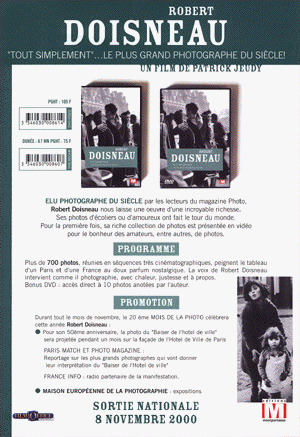

"La Boule Rouge, Paris (11th arrdt) 1951
Photo by Robert Doisneau
"I call her Anita. I don't know anything about her except her name. I never saw her again. She didn't stand out in the crowd until she took off her bolero. "It's a good thing I waited and built up the nerve... 'May I?' " 'Of course!' she replied. "And she removed her jacket by herself. And then... the chrysalis opened and a butterfly appeared."
Doisneau and Anita crossed paths when he worked on a photographic study of accordeon players and cabaret singers in working class neighborhoods. The photographer's reflection can be seen in the window to Anita's right.
Photograph taken in natural light with a Rolloflex camera. Shutter speed = 1/10 sec. Aperture = f/3.5
"I told Anita, 'Please don't move, don't change anything. I'll explain later...' "
This hour-long documentary about "the greatest photographer of the century," as he was described by the readers of Photomagazine, is comprised of photos and music, with commentary by Doisneau.
Available on November 8, 2000, in VHS and DVD
edited by Montparnasse and Film Office.

Why make a film with Doisneau today?
By Patrick Jeudy
The world is sad and cruel. Paris is a city disfigured by obtrusive construction sites, ostenatious renovation projects, cars and tourist buses, corporate urban architecture, McDonald's and Gap outlets. The poor are getting poorer and the rich envision themselves as glamorous models in glossy prints.
Doisneau is neither a prophet nor a moralizer, however, when we enter his world, a change takes place making black and white colorful. Various stories come to mind, stories we invent or remenber, stories we have been told or have experienced ourselves. The poor are not as miserable, the rich are less arrogant, lovers are bashful, and ugliness is less repulsive.
Yet the 1950's were not exactly a joyful decade in France. Post-war days were filled with various crises: housing, poverty, governmental conflict, the aftermath of decolonization.
America kept Doisneau from us for a while. Magazines like Life and Vogue were fond of his warm but sharp eye which photographed models clad in Dior dresses, posing in the dismal outskirts of the city.
He returned to France in the 1970's, a time when we were questioning our values, when the world went through further changes. Today, still, new photos are developed and printed in his workshop located in Montrouge. The same photos, yet not quite the same, and not quite different
What he sees comforts us and his photos become icons we hang on the walls of our youth, alongside a yellowed poster of Che Guevara.